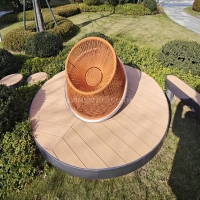Welcome to the website for landscape facilities products and knowledge.
What are the key differences between travertine and limestone landscape tables?
When selecting natural stone for outdoor furniture, travertine and limestone are two popular choices. While both offer timeless beauty, they differ significantly in composition, durability, and maintenance.
1. Formation and Appearance:
Travertine is a form of limestone deposited by mineral springs, featuring porous holes and a textured surface. Its color ranges from ivory to walnut, often with swirling patterns. Limestone, formed from marine fossils, has a smoother, more uniform appearance with subtle veining and neutral tones like beige or gray.
2. Durability and Weather Resistance:
Travertine is highly durable but requires sealing due to its porosity. It resists heat but can stain if unsealed. Limestone is denser and less porous, making it more resistant to scratches and weather, though it may erode over time in acidic environments.
3. Maintenance Needs:
Travertine demands regular sealing to prevent water absorption and staining. Limestone, while lower-maintenance, still benefits from occasional sealing to preserve its finish. Both stones should be cleaned with pH-neutral solutions.
4. Ideal Use Cases:
Travertine suits dry climates and covered outdoor areas, adding rustic charm. Limestone excels in high-traffic spaces and humid conditions, offering a sleek, modern look.
Choose based on your climate, design preferences, and willingness to maintain the stone’s longevity.
Related search:

Recommendation
Swivel chair-Specialty steel structure woven rattan leisure chair with rotatable design